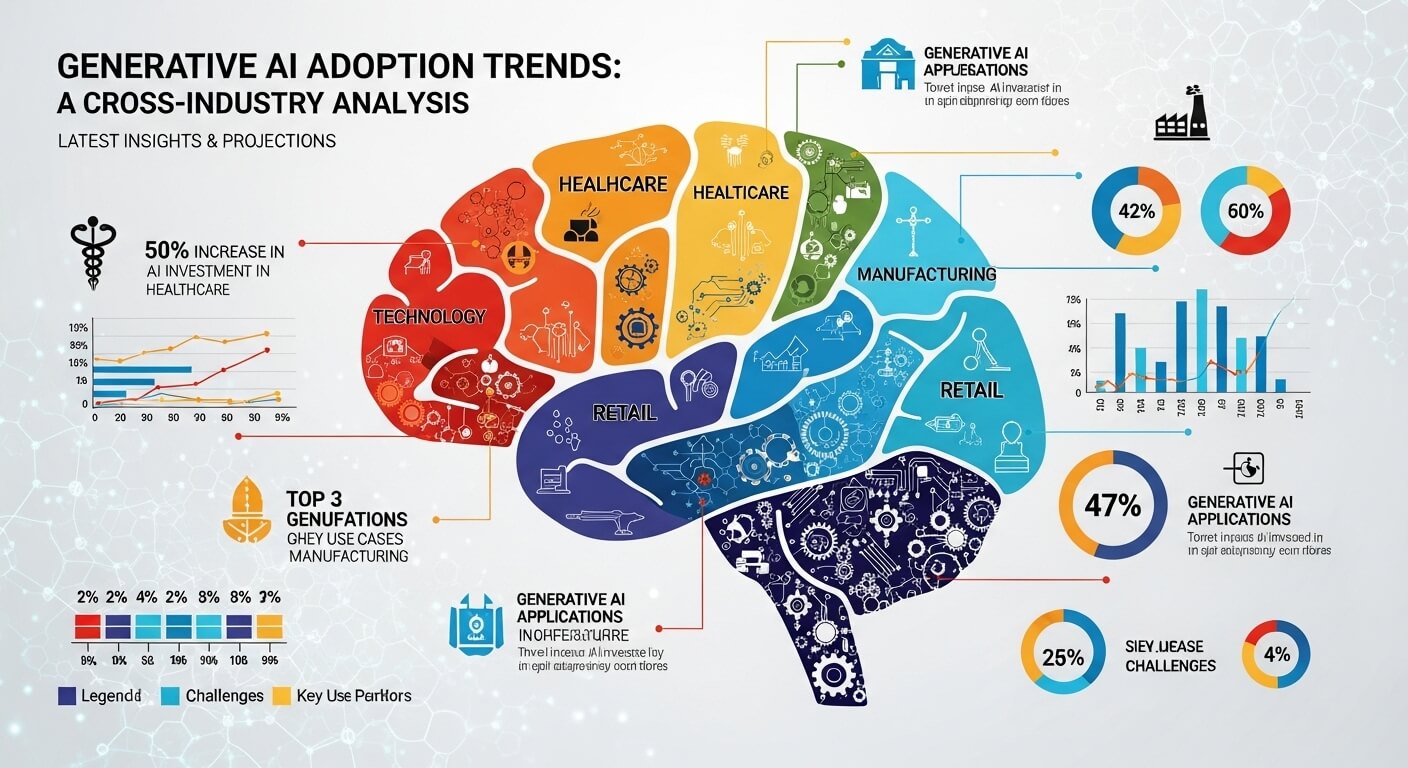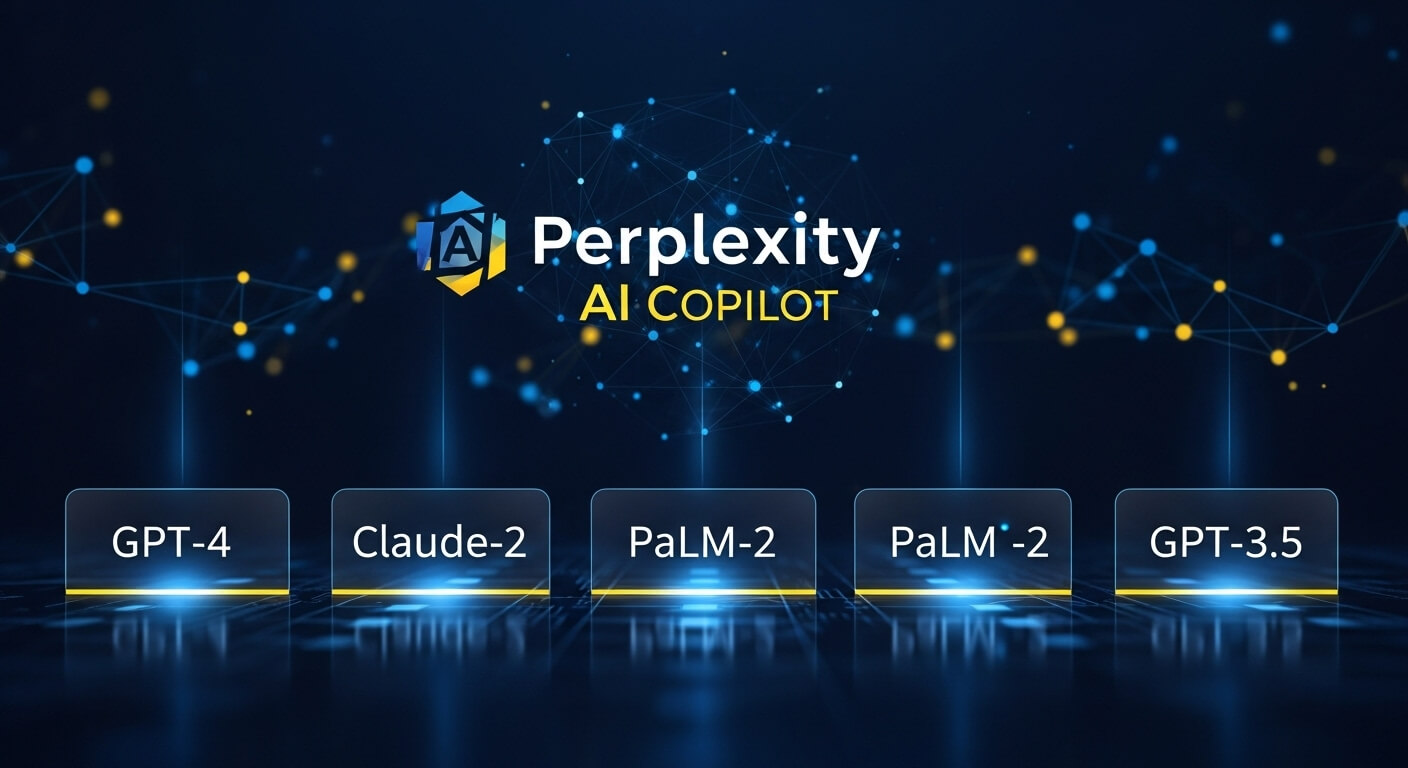Generative Artificial Intelligence (AI) is transforming industries worldwide, from healthcare to finance, by enabling innovative applications like content creation, process automation, and hyper-personalization. As businesses increasingly adopt generative AI, staying informed about the latest adoption trends is crucial for professionals, policymakers, and organizations aiming to remain competitive. This 3,000-word guide provides a comprehensive resource list, strategies, and insights on where to find the latest insights on generative AI adoption trends across major industries. By exploring authoritative reports, industry blogs, research platforms, and more, this article equips you with the tools to navigate the rapidly evolving generative AI landscape in 2025.
Why Tracking Generative AI Adoption Trends Matters
Generative AI, powered by advanced models like Large Language Models (LLMs), Generative Adversarial Networks (GANs), and transformer-based systems, is reshaping how industries operate. According to McKinsey, generative AI could contribute $6.1–7.9 trillion annually to the global economy, underscoring its transformative potential. Understanding adoption trends helps businesses:
- Identify high-impact use cases in their industry.
- Allocate budgets effectively for AI initiatives.
- Mitigate risks like data privacy and ethical concerns.
- Stay ahead of competitors by adopting innovative workflows.
- Upskill workforces to align with AI-driven processes.
This guide outlines the best sources for reliable, data-driven insights, covering platforms, publications, and communities that provide up-to-date information on generative AI trends.
Top Sources for Generative AI Adoption Trends
To find the latest insights on generative AI adoption across major industries, leverage these authoritative sources:
1. Industry Research Reports
Research reports from reputable firms offer in-depth, data-driven insights into generative AI adoption trends, market size, and industry-specific applications.
- McKinsey & Company:
- Resource: McKinsey Global Survey on AI (e.g., “The State of AI: How organizations are rewiring to capture value”).
- Why It’s Valuable: McKinsey’s annual surveys provide comprehensive data on AI adoption, including generative AI, across industries like healthcare, finance, and retail. The 2025 survey highlights that 65% of organizations regularly use generative AI, up 49% from 2023.
- How to Access: Visit www.mckinsey.com and search for “AI survey” or “generative AI report.”
- Key Industries Covered: Healthcare, finance, manufacturing, retail, and technology.
- Example Insight: 21% of organizations have redesigned workflows to integrate generative AI, driving significant EBIT impact.
- Gartner:
- Resource: Gartner Hype Cycle for Artificial Intelligence 2025.
- Why It’s Valuable: Gartner’s Hype Cycle tracks the maturity and adoption of AI technologies, including generative AI, AI agents, and AI-ready data. It notes that generative AI is entering the “Trough of Disillusionment,” with organizations focusing on scaling and governance.
- How to Access: Available via Gartner’s website (www.gartner.com) or through subscriptions. Free summaries are often shared at events like Gartner IT Symposium/Xpo.
- Key Industries Covered: Technology, finance, healthcare, and media.
- Example Insight: AI-ready data and AI agents are the fastest-growing AI technologies in 2025.
- StartUs Insights:
- Resource: Generative AI Report 2025.
- Why It’s Valuable: This report analyzes over 16,520 companies and 6,020 startups, highlighting trends like multimodal AI, ethical AI, and conversational AI. It projects the generative AI market to reach $1 trillion by 2034 with a 44.2% CAGR.
- How to Access: Download from www.startus-insights.com or request a sample database.
- Key Industries Covered: Finance, healthcare, manufacturing, and creative industries.
- Example Insight: The generative AI market employs over 944,000 professionals globally, with 151,000 new jobs added in the past year.
2. Industry Blogs and Publications
Blogs and publications from trusted sources provide timely updates, case studies, and expert commentary on generative AI trends.
- Forbes:
- Resource: Articles like “The Future of Generative AI: What to Expect in 2025” by Ashish Sukhadeve.
- Why It’s Valuable: Forbes offers expert-driven insights on generative AI’s impact across industries, such as hyper-personalization in retail and drug discovery in healthcare. It reports U.S. businesses plan to invest $67 million in generative AI in 2025.
- How to Access: Visit www.forbes.com and search for “generative AI 2025.”
- Key Industries Covered: Creative industries, healthcare, education, and cybersecurity.
- Example Insight: Generative AI in creative industries is projected to grow from $1.7 billion in 2022 to $21.6 billion by 2032.
- Harvard Business Review (HBR):
- Resource: “HBR’s Most-Read Gen AI Articles of 2025 So Far.”
- Why It’s Valuable: HBR compiles top articles addressing generative AI’s business implications, including adoption challenges and workforce upskilling.
- How to Access: Available at www.hbr.org under the AI section.
- Key Industries Covered: Business, technology, and management.
- Example Insight: 60% of managers anticipate a shift in entry-level roles to reviewing AI-generated outputs by 2028.
- Publicis Sapient:
- Resource: “The Top 5 Generative AI Trends in 2025.”
- Why It’s Valuable: Focuses on enterprise adoption, including AI agents and content supply chains. It notes 28% of U.S. workers use generative AI, with 11% using it daily.
- How to Access: Access the “Guide to Next 2025” report at www.publicissapient.com.
- Key Industries Covered: Retail, media, and technology.
- Example Insight: 65% of executives expect to integrate AI agents into business functions by mid-2025.
3. Data and Analytics Platforms
Specialized platforms provide quantitative insights into generative AI adoption, market growth, and startup ecosystems.
- StartUs Insights Discovery Platform:
- Why It’s Valuable: Tracks 7 million companies and 20,000+ technologies, offering data on 1,292 generative AI startups. It covers trends like hyper-personalization and intelligent process automation.
- How to Access: Visit www.startus-insights.com for reports or request a demo.
- Key Industries Covered: Retail, healthcare, manufacturing, and AEC (architecture, engineering, construction).
- Example Insight: Conversational AI employs over 966,300 professionals globally, with a 24.03% annual growth rate.
- Stanford AI Index:
- Why It’s Valuable: A trusted resource for global AI trends, reporting a 78% organizational adoption rate of AI in 2024, with significant generative AI growth.
- How to Access: Available at hai.stanford.edu under the AI Index section.
- Key Industries Covered: Technology, finance, and healthcare.
- Example Insight: AI adoption rose from 55% in 2023 to 78% in 2024, driven by generative AI implementations.
- AmplifAI:
- Resource: “60+ Generative AI Statistics You Need to Know in 2025.”
- Why It’s Valuable: Provides detailed statistics on adoption rates, ROI, and customer service applications. It notes a 40% adoption rate in North America.
- How to Access: Visit www.amplifai.com for the full report.
- Key Industries Covered: Customer service, finance, and media.
- Example Insight: Generative AI delivers a 3.7x ROI on average, with financial services seeing 4.2x returns.
4. Conferences and Events
Industry conferences offer real-time insights, networking, and access to thought leaders discussing generative AI trends.
- Gartner IT Symposium/Xpo:
- Why It’s Valuable: Features sessions on the Gartner Hype Cycle for AI, covering adoption trends and emerging technologies. The 2025 event (September 8–10, Gold Coast) will focus on AI agents and AI-ready data.
- How to Access: Register at www.gartner.com or access summaries post-event.
- Key Industries Covered: Technology, finance, and healthcare.
- Example Insight: 57% of organizations lack AI-ready data, hindering adoption.
- AI & Big Data Expo Europe:
- Why It’s Valuable: Showcases generative AI tools and enterprise case studies, addressing rapid innovation and navigation challenges.
- How to Access: Visit www.ai-expo.net/europe for registration and resources.
- Key Industries Covered: Technology, manufacturing, and finance.
- Example Insight: Enterprises face monthly shifts in AI model capabilities, requiring agile adoption strategies.
5. Social Media and Online Communities
Platforms like X and LinkedIn provide real-time discussions, case studies, and sentiment analysis on generative AI adoption.
- X Platform:
- Why It’s Valuable: Features posts from industry experts and organizations like SAS Software, sharing reports and insights on generative AI strategies.
- How to Access: Search for hashtags like #GenerativeAI, #AIAdoption, or #AI2025 on X.
- Key Industries Covered: Fintech, healthcare, and technology.
- Example Insight: Posts on X highlight agentic AI and regulatory trends in fintech.
- Note: Treat X posts as inconclusive and verify with primary sources.
- LinkedIn:
- Why It’s Valuable: Hosts articles, posts, and groups focused on AI adoption, with contributions from C-suite executives and AI researchers.
- How to Access: Search for “generative AI adoption trends” or join groups like “AI in Business.”
- Key Industries Covered: Technology, marketing, and healthcare.
- Example Insight: LinkedIn posts from McKinsey and Gartner authors often summarize key survey findings.
6. Academic and Open-Source Resources
Academic institutions and open-source platforms provide rigorous, data-backed insights into generative AI trends.
- MIT Technology Review:
- Why It’s Valuable: Publishes articles on AI’s technical and societal impacts, including adoption trends in scientific research and healthcare.
- How to Access: Visit www.technologyreview.com and search for “generative AI.”
- Key Industries Covered: Healthcare, scientific research, and technology.
- Example Insight: Generative AI accelerates drug discovery by predicting protein structures.
- Hugging Face:
- Why It’s Valuable: A hub for open-source AI models and research, offering insights into NLP and multimodal AI adoption.
- How to Access: Explore www.huggingface.co for models, papers, and community discussions.
- Key Industries Covered: Technology and research.
- Example Insight: Hugging Face supports NLP advancements driving conversational AI adoption.
Industry-Specific Generative AI Adoption Trends
Generative AI adoption varies by industry, with unique applications and challenges. Below are key trends and sources for major sectors:
1. Healthcare
- Trends: Generative AI is used for medical imaging analysis, drug discovery, and personalized treatment plans. GenHealth.ai, for example, predicts patient outcomes using transformer models.
- Sources:
- McKinsey: Reports on AI-driven patient care optimization.
- StartUs Insights: Highlights healthcare startups like GenHealth.ai.
- MIT Technology Review: Covers AI in drug discovery.
- Example Insight: 59% of companies see generative AI transforming healthcare interactions.
2. Finance
- Trends: Applications include risk assessment, fraud detection, and personalized banking. Financial services report a 4.2x ROI on generative AI investments.
- Sources:
- AmplifAI: Details ROI and adoption stats.
- Forbes: Discusses AI in financial personalization.
- Gartner: Covers AI governance in finance.
- Example Insight: India’s RBI projects a 46% increase in banking efficiency through generative AI.
3. Retail and E-Commerce
- Trends: Hyper-personalization drives product recommendations and marketing campaigns. Typeface AI creates tailored content for retail brands.
- Sources:
- Publicis Sapient: Discusses AI in content supply chains.
- StartUs Insights: Covers retail personalization trends.
- BCG: Surveys CMOs on AI personalization.
- Example Insight: 67% of CMOs are exploring generative AI for personalization.
4. Manufacturing
- Trends: Generative AI enhances quality control, predictive maintenance, and supply chain optimization. Synthetic data supports model training.
- Sources:
- StartUs Insights: Highlights generative 3D modeling in manufacturing.
- McKinsey: Covers AI in supply chain management.
- Gartner: Discusses AI-ready data in manufacturing.
- Example Insight: 44% of manufacturers are piloting generative AI programs.
5. Creative Industries
- Trends: Generative AI powers content creation, video production, and music generation. The market is projected to reach $21.6 billion by 2032.
- Sources:
- Forbes: Details creative industry growth.
- StartUs Insights: Covers generative music and video trends.
- Publicis Sapient: Discusses AI in content supply chains.
- Example Insight: Tools like DALL-E 3 and MidJourney are democratizing creative workflows.
High-Volume Questions About Generative AI Adoption Trends
To address user queries and align with search intent, here are answers to popular questions:
1. Where Can I Find Reliable Generative AI Adoption Statistics?
- Answer: Reliable statistics are available from:
- McKinsey Global Survey on AI (www.mckinsey.com): 65% adoption rate in 2024.
- StartUs Insights (www.startus-insights.com): Tracks 16,520 companies and 8700 patents.
- AmplifAI (www.amplifai.com): 60+ statistics on ROI and customer service.
- Tip: Use these platforms’ search functions for “generative AI statistics 2025.”
2. What Are the Top Industries Adopting Generative AI in 2025?
- Answer: Healthcare, finance, retail, manufacturing, and creative industries lead adoption. Key applications include:
- Healthcare: Drug discovery and patient outcome prediction.
- Finance: Fraud detection and risk assessment.
- Retail: Hyper-personalized marketing.
- Sources: McKinsey, StartUs Insights, Forbes.
3. How Fast Is Generative AI Being Adopted?
- Answer: Adoption is accelerating:
- 95% of U.S. companies use generative AI, up 12% from 2023.
- 44% of organizations are piloting programs, 10% in production.
- North America leads with a 40% adoption rate.
- Sources: Bain, AmplifAI, Stanford AI Index.
4. What Are the Challenges in Generative AI Adoption?
- Answer: Common challenges include:
- Data quality: 57% of organizations lack AI-ready data.
- Skill gaps: 45% of businesses lack talent for implementation.
- Governance: Concerns over hallucinations, bias, and regulations.
- Sources: Gartner, AmplifAI, McKinsey.
5. How Does Generative AI Impact Customer Service?
- Answer: 59% of companies see generative AI transforming customer interactions via chatbots and personalized support. 70% of CX leaders plan to integrate it by 2026.
- Sources: AmplifAI, Publicis Sapient.
- Example: WeBoard’s no-code chatbot Kaila automates customer support.
6. What Is the ROI of Generative AI Investments?
- Answer: Average ROI is 3.7x, with financial services achieving 4.2x. Businesses report 15.2% cost savings.
- Sources: AmplifAI, McKinsey.
- Example: Banking efficiency could rise 46% with generative AI.
7. How Can I Stay Updated on Generative AI Trends?
- Answer: Subscribe to:
- Newsletters: McKinsey, Gartner, MIT Technology Review.
- Blogs: Forbes, HBR, Publicis Sapient.
- Social Media: Follow #GenerativeAI on X and LinkedIn groups.
- Conferences: Gartner IT Symposium, AI & Big Data Expo.
- Sources: Gartner, Forbes, X posts.
Best Practices for Finding and Using Generative AI Insights
To effectively leverage these sources, follow these best practices:
1. Prioritize Authoritative Sources
- Focus on reports from McKinsey, Gartner, and StartUs Insights for data-backed insights.
- Cross-reference X posts with primary sources to verify accuracy.
- Use academic resources like Stanford AI Index for rigorous analysis.
2. Focus on Industry-Specific Data
- Search for reports tailored to your industry (e.g., healthcare, finance).
- Use platforms like StartUs Insights for startup-driven trends.
- Explore case studies in Forbes and Publicis Sapient for real-world examples.
3. Monitor Real-Time Updates
- Follow X hashtags (#AIAdoption, #GenerativeAI) for breaking news.
- Subscribe to newsletters from MIT Technology Review and Gartner.
- Attend webinars or conferences like AI & Big Data Expo for live insights.
4. Address E-E-A-T
- Experience: Reference case studies (e.g., Mondelēz’s AI-driven marketing).
- Expertise: Cite authors like Ashish Sukhadeve (Forbes) or Simon James (Publicis Sapient).
- Authoritativeness: Use data from McKinsey, Gartner, and Stanford.
- Trustworthiness: Include trust signals like citations and reputable sources.
5. Optimize for Emerging Trends
- Track trends like agentic AI, synthetic data, and hyper-personalization.
- Monitor regulatory developments, such as the EU AI Act.
- Stay updated on workforce upskilling needs, as 80% of engineers require training by 2027.
Case Studies: Generative AI Adoption in Action
Case Study 1: Healthcare (GenHealth.ai)
- Overview: Austrian startup GenHealth.ai uses generative AI to predict patient outcomes, supporting health insurance and pharmaceutical applications.
- Impact: Enhances treatment personalization and clinical trial simulations.
- Source: StartUs Insights.
Case Study 2: Retail (Mondelēz International)
- Overview: Partnered with Publicis Groupe to scale AI-driven marketing, personalizing content for regional preferences.
- Impact: Improved content creation speed and customer engagement.
- Source: Publicis Sapient.
Case Study 3: Banking (RBI Projection)
- Overview: India’s Reserve Bank projects a 46% efficiency increase using generative AI for automation and compliance.
- Impact: Reduced fraud and streamlined operations.
- Source: Tech-now.io.
Common Pitfalls to Avoid
- Relying on Outdated Data: Use 2025 reports from McKinsey or Gartner for current trends.
- Ignoring Industry Context: Focus on sector-specific insights (e.g., healthcare vs. retail).
- Overlooking Governance: Address ethical and regulatory challenges highlighted by Gartner.
- Neglecting Primary Sources: Verify X posts with reports from StartUs Insights or AmplifAI.
- Failing to Track ROI: Use metrics from AmplifAI to assess investment value.
How to Stay Ahead in 2025
To remain competitive:
- Subscribe to Newsletters: McKinsey, Gartner, and MIT Technology Review.
- Join Communities: LinkedIn groups and X discussions (#AI2025).
- Attend Events: Gartner IT Symposium, AI & Big Data Expo.
- Leverage Tools: StartUs Insights Discovery Platform, Stanford AI Index.
- Upskill: Take AI courses on Coursera or Salesforce’s training programs.
Conclusion
Finding the latest insights on generative AI adoption trends across major industries requires accessing authoritative sources like McKinsey, Gartner, and StartUs Insights, complemented by blogs, conferences, and social media platforms. These resources provide data-driven statistics, case studies, and expert commentary on applications in healthcare, finance, retail, and more. By prioritizing reputable sources, focusing on industry-specific trends, and staying updated through real-time channels, you can navigate the generative AI landscape effectively. Start exploring these platforms today to harness the power of generative AI and drive innovation in your organization.

The editor of All-AI.Tools is a professional technology writer specializing in artificial intelligence and chatbot tools. With a strong focus on delivering clear, accurate, and up-to-date content, they provide readers with in-depth guides, expert insights, and practical information on the latest AI innovations. Committed to fostering understanding of fun AI tools and their real-world applications, the editor ensures that All-AI.Tools remains a reliable and authoritative resource for professionals, developers, and AI enthusiasts.



